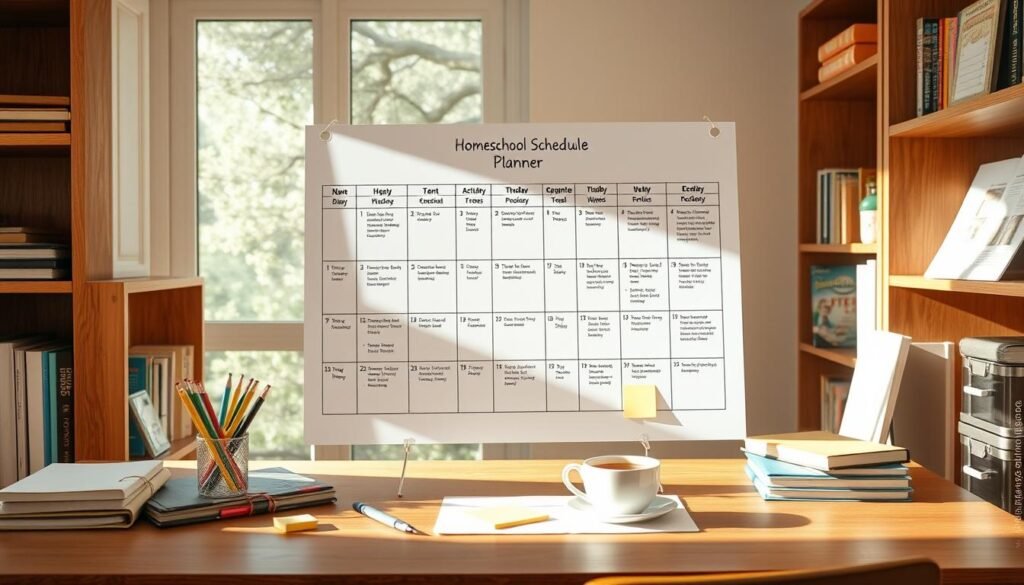
Creating the perfect homeschool schedule can change your family’s learning journey. It doesn’t have to be strict or stressful. Flexible learning makes education more fun and engaging.
Homeschooling lets you tailor education to your child’s needs. Most families spend about four hours a day on learning. This way, you can make a schedule that fits your child’s learning style and pace.
Remember, every family’s homeschool routine is unique. Start with 30 minutes of formal learning in kindergarten and increase it as needed. This approach keeps kids motivated and excited about learning.
Table of Contents
Understanding Year-Round Homeschool Scheduling
Homeschool planning needs creativity and flexibility. Year-round homeschooling is a unique way to learn that doesn’t follow traditional school calendars. It spreads out learning all year, giving kids a steady flow of education.
Traditional school calendars can disrupt learning. About 26% of homeschoolers now use year-round schedules to avoid the “summer slide.” This is when students lose some of what they learned during long breaks.
Benefits of Year-Round Learning
- Reduces learning loss between academic terms
- Provides more frequent breaks for students and parents
- Allows for flexible homeschooling schedules
- Maintains consistent educational momentum
Preventing Academic Burnout
Year-round homeschooling stops burnout by adding smart breaks. Families can make schedules that fit their needs, like:
- 6 weeks of school, then 1 week off
- 4-day school weeks with flexibility
- 3 months of school, then 1 month off
Maintaining Educational Momentum
| Scheduling Approach | Weeks of School | Weeks of Break |
|---|---|---|
| Traditional Approach | 36 weeks | 16 weeks |
| Year-Round Approach | 40 weeks | 12 weeks |
Using a smart year-round plan makes learning fun and keeps kids from losing too much. Flexible homeschooling lets you tailor education to your family’s pace and needs.
Essential Components of a Successful Homeschool Routine
Creating a good homeschool routine needs careful planning and organization. Studies show that a well-organized routine can boost student engagement and learning by about 20%. It’s important to find a balance between structure and flexibility to fit your family’s needs.
When setting up your homeschool routine, keep these key points in mind:
- Focus on 3-5 core subjects to avoid feeling overwhelmed
- Have daily anchor activities for consistency
- Make sure to include regular breaks and physical activities
- Set aside time for personalized learning
Your homeschool organization plan should focus on core subjects but also leave room for creativity. Successful families usually spend 1-1.5 hours each day on focused academic work. They spread out learning across different subjects.
| Component | Recommended Time | Purpose |
|---|---|---|
| Core Subjects | 1-1.5 hours | Reading, Writing, Math |
| Science/Technology | 2 sessions/week | Specialized Learning |
| Morning Exercise | 30 minutes | Physical Development |
Flexibility is key in homeschool routines. About 60% of homeschooling parents change their schedules often to keep up with life. By making your routine flexible, you’ll make learning more enjoyable and effective for your family.
Different Types of Homeschool Schedule Ideas
Creating the right homeschool schedule can change your learning experience. Every family’s educational path is unique. Choosing the best homeschool timetable needs careful thought about your needs and learning styles.
Looking at different homeschool schedule ideas can help you make a flexible and effective learning space. Let’s explore three common scheduling methods that can help meet your educational goals.
Traditional Five-Day Schedule
The traditional five-day homeschool schedule is similar to regular school. It includes:
- A consistent daily learning routine
- Learning multiple subjects each day
- A structured academic progression
About 50% of homeschooling families prefer this schedule because it feels familiar. It’s especially popular among those moving from traditional schools.
Block Scheduling Approach
Block scheduling is a different homeschool timetable that focuses on fewer subjects for longer periods. Its benefits are:
- Deeper subject immersion
- Less subject switching each day
- More focused learning time
| Schedule Type | Subjects per Day | Learning Intensity |
|---|---|---|
| Traditional Schedule | 5-6 subjects | Moderate |
| Block Schedule | 2-3 subjects | High |
Flexible Four-Day Week
A four-day homeschool schedule offers more flexibility. It allows for:
- A dedicated day for field trips
- More time for extracurricular activities
- Time for catch-up or project work
About 50% of homeschooling families choose a four-day learning week. This shows its growing appeal among home educators.
Creating a Daily Structure for Young Learners
Creating a homeschool routine for young learners needs careful planning. It’s important to understand their unique needs. For kindergarten-aged children, a good routine balances learning and play, making learning fun and exciting.
A typical homeschool routine for young learners might look like this:
- Morning start at 9:00 a.m. with calendar and weather activities
- Short reading and handwriting practice (10-15 minutes)
- Interactive learning sessions with breaks for physical movement
- Hands-on activities that make learning fun and engaging
Key elements of an effective homeschool routine include:
- Flexible scheduling that adapts to your child’s energy levels
- Incorporating multiple short learning sessions
- Balancing structured learning with creative play
| Time | Activity | Duration |
|---|---|---|
| 9:00 AM | Morning Circle Time | 30 minutes |
| 11:00 AM | Reading and Handwriting | 15 minutes |
| 1:30 PM | Math Practice | 30 minutes |
A successful homeschool routine should be flexible. Watch your child’s engagement and adjust activities as needed. The goal is to create a loving, supportive learning environment that fosters curiosity and growth.
Balancing Academic and Extracurricular Activities
It’s important to mix learning with fun activities in homeschooling. Your plans should help your child grow in both mind and spirit.
Incorporating Sports and Physical Activities
Exercise is key for your child’s health. Add sports and physical activities to their day. This boosts:
- Physical fitness and health
- Social interaction
- Skill development
- Stress reduction
Managing Social Activities
Homeschooling doesn’t mean being alone. Look for ways to connect through:
- Local homeschool co-ops
- Community classes
- Group learning experiences
- Team sports
Planning Field Trips and Outings
Field trips make learning exciting. Flexible homeschooling lets you plan trips that match your lessons and spark curiosity.
Research shows that students who balance academics with extracurricular activities have a 15% higher graduation rate.
Use online tools to keep track of activities. This helps schedule and avoid overloading your child.
Designing Independent Learning Time for Older Students

As students get older, learning on their own becomes key in homeschooling. It helps them learn to manage time, take responsibility, and stay disciplined in their studies.
To make independent learning work, you need a good plan. Here are some important steps to help your older students:
- Set clear daily learning goals
- Provide comprehensive resources
- Establish regular check-in points
- Create a dedicated study space
Start by giving your students some time to learn by themselves. Begin with 1-2 hours each day. This helps them feel more confident and in control while keeping up with their studies.
It’s important for parents to support their students’ learning without controlling it too much. Talking about their progress, challenges, and how they learn can keep them motivated and focused.
The goal is to transform students from passive learners to active, self-motivated scholars.
Keeping track of how students are doing is crucial in homeschooling. Use digital tools, weekly journals, or reports to see how they’re doing. This helps you make changes to their learning plan if needed.
Incorporating Break Times and Rest Periods
Creating a good homeschool routine is more than just teaching. It’s also about taking breaks to keep students focused and avoid burnout. Studies show breaks can boost attention by up to 30%. This makes them key for flexible homeschooling.
Breaks do many things in your homeschool day. They let students rest, think, and stay excited about learning. Most homeschool families take 10-15% of their day for these breaks.
Short Breaks Between Subjects
Short breaks can really help students learn better. Here are some tips for great mini-breaks:
- Physical movement activities (5-10 minutes)
- Quick stretching exercises
- Brief mindfulness moments
- Hydration and healthy snack breaks
Longer Rest Periods for Rejuvenation
Long breaks are also vital in your homeschool day. They stop burnout and offer chances for learning and bonding with family.
| Break Type | Duration | Purpose |
|---|---|---|
| Midday Break | 30-45 minutes | Lunch, relaxation, physical activity |
| Weekly Rest Day | Full day | Family time, exploration, recovery |
Seasonal Break Planning
Flexible homeschooling lets you plan breaks that fit your family’s life. The Sabbath schedule, with six weeks of school and one week off, keeps learning fresh without exhaustion.
Remember, breaks are not a waste of time. They’re crucial for learning well. Adjust your breaks to fit your family’s needs and watch your homeschool flourish.
Adapting Your Schedule for Multiple Children

Homeschool planning gets tricky when you have many kids with different needs. You need a flexible, creative plan to help each child learn in their own way.
Creating a good schedule for many kids takes some smart planning:
- Give each child their own time with you
- Help them learn from each other
- Make learning blocks that fit different ages
- Try loop scheduling for all subjects
Here are some tips to organize homeschooling for kids of different ages:
For the little ones, start with 20 minutes of focused learning per subject. Older kids can learn more on their own. This lets parents switch between teaching different ages.
Here are some key tips for homeschooling many kids:
- Make a daily schedule that everyone can see
- Let kids help plan their learning
- Use group learning to help them work together
- Set clear rules for when they work alone
Being flexible is key. While routine is good, your homeschool plan should fit your family’s special needs. Use this chance to make a learning space that helps each child grow.
Utilizing Technology and Resources in Your Schedule
Technology has changed how we teach at home, making learning more fun and efficient. Families can use digital tools to make school more engaging and easy to manage.
Digital tools offer great solutions for homeschooling families. They help create flexible and interactive learning spaces. Learning how to use these tools can greatly improve your homeschooling.
Digital Planning Tools for Homeschoolers
Good homeschool organization needs strong digital planning tools. Here are some top digital resources:
- Google Calendar for scheduling
- Trello for project management
- Todoist for tracking assignments
- Evernote for curriculum documentation
Online Learning Platforms
Online platforms add variety to your homeschool curriculum. Here are some great platforms:
| Platform | Subject Focus | Age Range |
|---|---|---|
| Khan Academy | Mathematics, Science | K-12 |
| Coursera | Advanced Subjects | High School/College |
| Duolingo | Language Learning | All Ages |
Educational Apps and Software
Specialized educational apps can make learning exciting. 65% of learners benefit from visual resources, making interactive apps very effective.
- Scratch for coding skills
- Photomath for mathematics
- Quizlet for study flashcards
- Kahoot for interactive learning
It’s important to balance digital learning with hands-on activities. Technology should help, not replace, traditional learning methods in your homeschool.
Conclusion
Your homeschool journey is special and needs careful planning and flexibility. Finding a homeschool routine that fits your family is key. The right schedule can make learning exciting and inspiring.
Remember, your homeschool routine can change as needed. The best schedules are creative and flexible. Tools like digital and paper planners help track progress and keep things organized.
The best homeschool schedule balances learning with family life and interests. It’s important to be open to changes, no matter the age of your students. Create a learning space that sparks curiosity and supports everyone’s strengths.
Your homeschool path is yours alone. Trust yourself to create a schedule that matches your family’s values and goals. With patience and creativity, you’ll make a routine that educates and inspires your kids.
